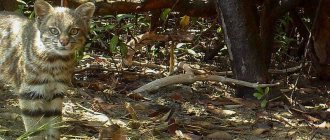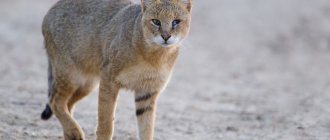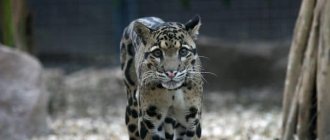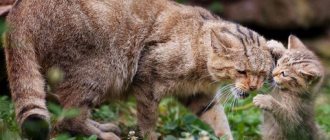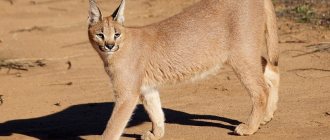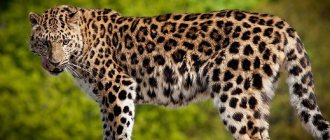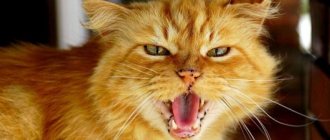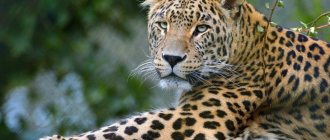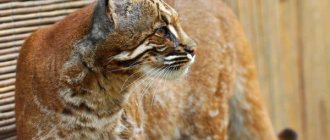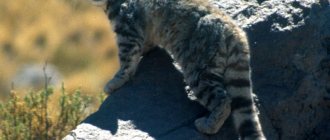Oncilla cat is a unique animal of the cat family, living in the vastness of Central and South America, Argentina, Brazil, Colombia and Costa Rica. There are quite a few cats of this breed in the world today; they are considered very rare and are on the verge of extinction. It has a brindle coloration, which gives it similarities with the jaguar. Its hunting behavior is also reminiscent of the habits of cats leading their lifestyle in the wild.
By family ties, Oncilla is related to the Chilean kitty and the Geoffroy cat. Experts also gave her a middle name - Felis tigrinus (tiger kitten). It is popular, and wealthy people often try to get a “little tiger” at home. What makes this breed so unique?
History of the discovery of the breed
The first to describe the cat Oncilla was the German naturalist and physician Johann Christian von Schreber in 1775. To date, several subspecies of the animal have been taken into account, which differ in the place of residence of Oncilla. Subspecies are easily identified by differences in color, coat size and saturation, ear shape and general appearance.
Wild cat subspecies names include:
- Classic subspecies Leopardus tigrinus , discovered by Schreber in 1775. Habitat: French Guiana, Venezuela, Guyana, Brazil.
- Leopardus tigrinus pardinoides (discovered by Gray in 1867). Lives in Colombia, Venezuela, Peru, Ecuador.
- Leopardus tigrinus guttulus (discovered by Hensel in 1872). Distribution area: central and southern Brazil.
- Leopardus tigrinus oncilla (discovered by Thomas in 1903). Habitat: mountain wet forests of Panama and Costa Rica.
Links[edit]
- ^ B s d e e Payan, E. & de Oliveira, T. (2016). "Leopard tigrinus". IUCN Red List of Threatened Species
.
2016
: e.T54012637A50653881. - ^ ab Wozencraft, W. C. (2005). "Species Leopardus tigrinus". In Wilson, Delaware; Reader, D. M. (ed.). Mammal Species of the World: A Taxonomic and Geographical Guide (3rd ed.). Johns Hopkins University Press. item 539. ISBN. 978-0-8018-8221-0. OCLC 62265494.
- ^ab Trigo, T.C.; Schneider, A.; de Oliveira, T. G.; Lehugeur, L.M.; Silveira, L.; Freitas, T. R. O., & Eizirik, E. (2013). "Molecular evidence reveals complex hybridization and cryptic species of Neotropical wildcat". Current Biology
.
23
(24):2528–2533. DOI: 10.1016/j.cub.2013.10.046. PMID 24291091. - ^ ab Leyhausen, P. (1963). "Über südamerikanische Pardelkatzen". Zeitschrift für Tierpsychologie
.
20
(5): 627–640. DOI: 10.1111/j.1439-0310.1963.tb01179.x. - ^ abcd Sunquist, M.; Sunquist, F. (2002). Wild cats of the world. Chicago: University of Chicago Press. pp. 130 -134. ISBN 0-226-77999-8.
- University of Michigan Museum of Zoology
- Meyer, N. F., Esser, H. J., Moreno, R., van Langevelde, F., Liefting Y., Oller, D. R., Vogels, C. B. Carver, A. D., Nielsen, C. K. & Jansen, P. A. (2015). "Assessing terrestrial mammal communities in the forests of Central Panama using camera trap surveys". Journal of Nature Conservation
.
26
(26): 28-35. DOI: 10.1016/j.jnc.2015.04.003.CS1 maint: multiple names: authors list (link) - Rodgers, T. W., & Kapheim, K. M. (2017). "Altitude record of the small spotted cat (Leopardus tigrinus oncilla) from Western Panama". Southwestern Naturalist
.
62
(3): 225-227. DOI: 10.1894 / SWNAT D-17-00024.1 .CS1 maint: multiple names: authors list (link) - Payana, E. G. & Gonzalez-Maya, J. F. (2011). "Distribución geográfica de la Oncilla ( Leopardus tigrinus
) en Colombia e implaciones para su conservación."
Revista Latinoamericana de Conservación [Latin American Journal of Conservation]
.
2
(1): 51-59. - Arias-Alzate, A., Sanchez-Londoño, J. D., Botero-Canola, S., & Gonzalez-Maya, J. F. (2014). "Recent confirmed records of oncilla ( Leopardus tigrinus
) in the department of Antioquia, Colombia."
Notas Mastozoológicas
.
1
(2): 4-5.CS1 maint: uses authors parameter (link) - Leyhausen, P. & Tonkin, B. A. (1979). “Cat behavior. Predatory and social behavior of domestic and wild cats." New York: Garland STPM Press. Cite journal requires |journal= (help)
- ^ abc Nowell, K., Jackson, P. (1996). Wildcats: A Status Review and Conservation Action Plan. Hardware: IUCN.CS1 maint: multiple names: authors list (link)
- Quillen, P. (1981). "Hand raising a spotted cat or oncilla." International Yearbook of Zoos
.
21
: 240–242. DOI: 10.1111/j.1748-1090.1981.tb01994.x. - ^ a b de Oliveira, T., Schipper, J., & Gonzalez-Maya, J. F. (2008). "Leopardus tigrinus ssp. Oncilla". IUCN Red List of Threatened Species
.
2008
.CS1 maint: uses authors parameter (link) CS1 maint: ref=harv (link)old-form url - https://felids.wordpress.com/2010/11/03/featured-feline-oncilla/ International Endangered Cat Society
- Lucerini, M.; Eizirik, E.; de Oliveira, T.; Pereira, J.; Williams, R. S. R. (2016). "Bell Leopard". IUCN Red List of Threatened Species
.
2016
: e.T15309A97204446. DOI: 10.2305/IUCN.UK.2016-1.RLTS.T15309A97204446.en. Retrieved January 15, 2018. - do Nascimento, F.O.; Feijo, A. (2017). "Taxonomic revision of the tigrina species group Leopardus tigrinus (Schreber, 1775) (Carnivora, Felidae)". Papéis Avulsos de Zoologia
.
57
(19): 231–264. DOI: 10.11606/0031-1049.2017.57.19. - ^ abc Forman, G. E. (editor) (1988). "Bibliography of Felid 1781-1988". Columbus, OH: Felid Research and Conservation Interest Group: 34–72. Cite journal requires |journal= (help)CS1 maint: extra text: authors list (link)
- ^ abc Fuller, K. S., Swift, B. (1985). Latin American Wildlife Trade Laws
. Washington, DC: Traffic (USA).CS1 maint: multiple names: authors list (link) - Eizirik, E.; Trigo, T.S.; Haag, T. (2007). "Conservation genetics and molecular ecology of Neotropical felids". In Hughes, J.; Mercer, R. (ed.). Felid Biology and Conservation Conference September 17–19
. Oxford, UK: WildCRU. pp. 40–41.
Classification of wild cats
In 1999, researcher Johnson described the strict differences between Leopardus tigrinus oncilla and Leopardus tigrinus guttulus . This gave scientists a reason to divide Oncilla into two main species. These two separate populations were completely isolated along the Amazon River for 3.7 million years. The described species lived separately and did not interbreed.
However, in 2013, Leopardus guttulus (as researchers began to call it for short) was identified as a separate species - the southern tiger. Its habitat is the subtropical forests of Brazil, Paraguay, Uruguay and Argentina. Through a morphological assessment of the subspecies, scientists came to the conclusion that there are three groups of Oncilli cats according to their region of residence on the South American continent: northwestern, eastern and southern.
General information
Origin
In 2022, based on research results, three groups of oncilla cats were approved, one of which was recognized as an independent species - the tiger cat. Although, it is difficult for the average person to accept this division, because the classification is based on the texture and variety of patterns on the skins.
Appearance
Although the oncilla is called a tiger cat, it looks like a very small jaguar or its cub. In relation to the size of an ordinary domestic cat, this species of wild cat is slightly larger, but most often about the same.
Females are almost half the size of males, so if we talk about size, you should always consider the lower threshold to be the size of a female, and the upper threshold to be the size of a male. So the body of an adult oncilla is 38-65 centimeters, plus a tail that is 2/3 the length of the body. The weight of a male usually does not exceed 3 kilograms, and that of a female 2.
In terms of the structure of the skeleton and muscles, the cat is built, like all wild species, very harmoniously, has a small flattened head and an elongated muzzle. The ears are without tassels, with sparse white hairs inside and thick black fur on the back wall. The eyes are slightly bulging, the iris is yellow-brown. The nose is charmingly pink, with a black edging. It is distinguished by the extremely close location of the mustache to the nose.
The paws are thin, long, and the pads can hide and extend their claws to their entire length.
IMPORTANT: the population of mini-jaguars is protected by the Red Book as a vulnerable species. This is due to the reduction of natural habitat by humans
The entire color palette of this wild cat is aimed at camouflage in dark foliage and the play of sunlight among the leaves.
INTERESTING: Among wild oncilla cats, approximately 15% of the population are always black. This phenomenon is caused by melanism and is common in many wild tabbys.
Habits and life in the wild
Small, but remote, and also extremely cunning and a real special forces specialist in matters of camouflage - all this is about the tiny oncilla, which, thanks to all these qualities, was able to hide from humans for so long. But the adult oncilla is in no hurry to make contact with its relatives. Active contacts occur only during the rutting period.
The tiger cat does all its business at night; wakefulness during the day is extremely rare and is always caused by a serious irritant in the territory. Oncilla spends 90% of its time on tree branches, where its camouflage ability makes it invisible to most predators and humans in particular.
The habitat of an adult female is approximately 2.5 kilometers, but the male appropriates up to 17 square kilometers. The ranges of males and females may touch, but not overlap. The male and female spend a lot of time just before mating. The period of courtship and being together with cats of this species is very gentle and touching. Typically this period lasts 3-9 days, after which the partners disperse back to their territories.
When hunting, the oncilla doesn’t care where its prey is. This striped cat climbs trees and branches better than any monkey, it also swims and runs excellently, and its assertive and ferocious disposition will not give its prey any chance of escaping. But this does not mean that the oncilla rushes through the jungle for everything that is tasty. She can sit in ambush for enough time to attack at a moment when the victim does not see her at all and does not hear her jump.
Wild oncilla never stores prey on branches, as leopards do, for example. She catches what she can eat at a time and hunts every night for this reason. The most delicious for a tiger cat: mice and rats, gophers, birds, frogs, fish, lizards, macaques and snakes. An interesting fact is that the oncilla not only eats the bird’s carcass, it cleans it of feathers, and can also then feast on the contents of the nest.
When there is a “failure” of small animals in the jungle, the oncilla does not mind snacking on large beetles and larvae.
Characteristics of Oncilla
Externally, the Oncilla cat resembles a small jaguar. It is difficult to recognize a mature kitten among the cubs of the jaguar itself. Among wild cats, it is one of the smallest, in appearance it is slightly larger than an ordinary domesticated breed.
Brindle color
External features
The characteristics of the external physique are as follows:
- The coat color is usually sandy; completely black Oncillas are extremely rare.
- The coat pattern is brindle and consists of random spots.
- Weight reaches parameters up to 2 kg in cats and up to 3 kg in males.
- Body length: 75 cm – females, 80 cm – males.
- The length of the tail is 27 cm in females, 31 cm in males.
- The head is small, elongated.
- The ears are large, with a black outer surface.
- The eyes are large, the color of the eyes is greenish or yellow.
- Posture is straight, the back has visually elastic features.
- The coat is short, thick, smooth to the touch.
Where do Oncillas live?
The main place of residence is the northeast of the South American continent. Among the features of their habitat are the following:
- Oncillas prefer to live in subtropical forests with high humidity above 1500 m above sea level.
- In forests with deciduous trees, their population is found no higher than 1500 m above sea altitude.
- In Brazil, these wild creatures can choose to live in dry savannah areas.
- The distribution altitude of the population reaches the range of 350-3200 m above sea level.
The population of Oncilli cats in nature numbers approximately 50 thousand adult individuals, which is a critically small number, therefore they are under state protection. Changes in the population towards decrease occur due to deforestation of forest areas and hunting by poachers.
Security status
Oncilla is known as the small spotted cat, tiger cat, ocelot, or tigrillo, but these names are also used to describe the margay and ocelot cats because their geographic range overlaps significantly.
Oncilli can be mistaken for long-tailed cats (margays) or juvenile ocelots, meaning their presence is difficult to detect in any area. Researchers in Brazil found that few former hunters and the most experienced indigenous people could tell the three species apart.
In southern Brazil, their range overlaps with Geoffroy's cats, and there is some evidence of hybridization between the two species.
Oncillas have been hunted for their fur throughout their range. A report on South American cats found that between 1976 and 1982, oncillas were one of the four most traded small cat species. It is difficult to assess threats to this species when so little is known about it. Scientists suggest the possibility of oncilla existence in deforested coffee and eucalyptus plantations on the outskirts of São Paulo.
Oncillas are classified as "vulnerable" on the IUCN Red List of Threatened Species. Although these cats are protected under Appendix I of CITES (Convention on International Trade in Endangered Species of Wild Fauna and Flora), they are rarely found in protected habitats. The phylogenetics of this species are not well established, and it has been suggested that populations that occur in the northernmost part of their range may represent a distinct species.
At the end of the 20th century, oncillas were a very popular hunting object among poachers. This species gained such popularity due to the beauty of its fur. At the moment, the population of these cats numbers up to 50 thousand individuals. The main threat to the species remains poachers, as well as coffee production, for the cultivation of which forests are cut down in the oncilla's habitats. Hunting these cats is prohibited by law in most countries that cover their habitat.
If you find an error, please highlight a piece of text and press Ctrl Enter.
How do they behave in the wild?
Due to its small size, Oncilla in the wild runs the risk of injury from larger relatives, including predators. Therefore, she is very careful and leads a life closed from view. But there are times when it boldly enters into a fight with a larger predator and wins it.
Characteristics of Oncillus behavior include the following features:
- Activity occurs in the dark - late evening or early morning.
- During marriage, he gets along with a representative of the same sex, but then prefers to live alone.
- The Oncilla cat lives most of its life in trees, where it sleeps, eats and hunts.
- Both sexes of this breed ardently protect their habitat and can fight with each other. An exception occurs during the mating period of individuals.
- He knows how to swim and feels free in the water.
- Hunting is done from cover. The victims are birds and small rodents. First, the kitty looks for a victim for a long time, and then attacks it.
- The animal is a monogamous animal; in captivity it prefers mating with only one individual of the opposite sex.
Felis tigrinus tiger kitten
Hunting and diet
Like all cats, oncilla is a predator. Despite their small size, these animals are very dexterous and skilled hunters, who often kill prey larger than themselves. They prefer to hunt at night. Having spotted a victim, a wild cat can wait in ambush for hours, looking for the right moment to attack. When an unsuspecting animal comes close enough, the oncilla quickly rushes at it, catching up in a few seconds.
Unlike domestic cats, these predators do not have the habit of playing with their prey and kill it with one precise blow to the neck or head. In this they are helped by sharp, strong claws and unusually strong fangs. The diet of oncillas includes:
- small rodents that share their habitat with these wild cats;
- birds from which the predator carefully plucks the feathers before eating;
- eggs left in nests;
- small non-venomous snakes and tree frogs (according to unconfirmed reports);
- fish - if the animal lives near a body of water.
According to some eyewitnesses, in Brazil, oncillas sometimes prey on small monkeys. Their excellent tree-climbing skills allow exotic cats to catch up and kill agile primates, providing themselves with a hearty meal. In hunting, predators are helped not only by their speed and grace, but also by very acute hearing, as well as an excellent sense of smell, which allows them to track prey in the twilight of night forests.
Oncilla mating
Males are ready for the mating process at the age of two; females reach sexual maturity at 1.5 years. The mating season takes place in February-March, marked by wild colors and screams - oncillas show a storm of emotions at this time. Mating games last up to 9 days, after which the male leaves and completely does not take part in raising the cubs. In the wild, permanent pairs are not often found due to the aggressiveness of the Oncilli breed.
The gestation period of individuals is from 74 to 78 days. Childbirth usually ends with one baby, very rarely two or three. The average weight of kittens is 100 g. Babies open their eyes 3 weeks after birth. At the same time, teeth erupt. Feeding lasts up to 3 months; from the age of 4 months, kittens become independent from their mother and can exist independently. The lifespan can reach 15 years.
Appearance description
The name "oncilla" translates as "little jaguar". Externally, this cat really looks like a miniature jaguar, not only in color, but also in physique, as well as the general structure of the body.
The animal's fur is soft, but rather short, and the main color is grayish-red. The belly and chest are lighter than the back and sides. Black longitudinal spots stretch along the spine, the tip of the tail is covered with transverse stripes. Dark rings of different shapes and sizes are randomly located throughout the body, not breaking up into specks. Among these predators, individuals with melanism and black coloration are often found - their number reaches 20% of the population.
The size of the wild oncilla is quite small - it is slightly larger than a domestic cat, but is inferior in size to the ocelot and its other relatives that do not live in tropical zones. The weight of a large male is about 2.8−3 kg with a body length of 65 cm. Females are smaller - their body weight rarely exceeds 1.5−2.5 kg. The predator's physique is quite powerful, but this does not prevent him from being dexterous and graceful. The tail is of medium length (up to 35-40 cm) and thickness, mobile. The front legs are slightly shorter than the hind legs. The claws are retractable, strong and sharp.
The ears are rounded, erect and very large, there are no tufts on them. Their light inner part is covered with light fluff, and the outer part is covered with black fur. There is a small white spot approximately in the middle of each ear. There are also characteristic light markings on the animal’s face in the area of the eyelids, cheeks and chin. The eyes of oncillas are large and expressive, very prominent against the background of the entire appearance of the cat. Their color varies from amber yellow and light brown to chocolate. The pupils are narrow and vertical.
Best articles: TOP 10 dog breeds suitable for apartments - small, medium and large
Place in the ecosystem
The wild Oncilla breed lives in the subtropical forests of Central and South America, Brazil, Argentina, Paraguay, Guyana, Peru, and French Guiana. It is difficult to see these animals in the trees due to their small numbers. However, there are cases when tiger cats were located near human habitation.
Oncillas perform an important function in the ecosystem of the entire planet as predators. They clean the areas in which they live from harmful rodents and small pests.
Reproduction
Mating calls, which allow males and females to find each other during sexual hunting, are similar to ordinary meowing, only greatly amplified. Such screams can be heard over long distances. Ocelots mate throughout the year. The time of maximum sexual activity depends on the region of residence. Thus, animals living in Paraguay and Argentina more often look for a sexual partner in the fall, and residents of Mexico and the state of Texas - in the fall and winter. Estrus in females lasts from three days to a week. If pregnancy does not occur, the female is ready for mating again after 4 weeks.
Biological studies have shown that in wild small cats living in Brazil, maximum sperm production is achieved during the summer months. Having found a suitable female, the male spends several days with his chosen one, without being separated even for hunting and eating. During these days, the couple communicates intensively, constantly sniffing and caressing.
A mother cat usually gives birth to one to three kittens. Pregnancy lasts 77-85 days. To care for the offspring, the mother prepares in advance a comfortable nest, securely hidden among dense thickets. The weight of a newborn kitten is about 300 g. Observations carried out in Texas showed that as mothers grow older, they move their cubs to new places.
For the first two weeks of life, babies remain blind, then the kittens' eyes open. The cubs leave the shelter for the first time when they reach the age of 12 weeks. Adolescents begin to lead an independent life after the age of two, and until then remain under maternal supervision. At 2 years old, young cats can already search for prey without the help of adults and defend their own hunting grounds.
When comparing Ocelots with other felines, biologists note a larger gap between births and a small number of cubs in one litter.
In nature, representatives of the species live 15-20 years, in captivity they can live up to 30 years. Females reach the ability to mate by one and a half years, males - six months later. Another distinctive feature of representatives of the species is the care that males show towards members of their family. The cat does not leave his wife while bearing offspring, and then takes care of the children, protecting them from danger and obtaining food.
Buying an Oncilla kitten
Despite the fact that fishing is prohibited by the state. Since this type of cat is at the stage of extinction, it is still possible to purchase an Oncilla kitten in special enclosures where they are raised for sale. Such a nursery must be strictly specialized, since it needs to be grown using special methods.
Frisky kids
Each person has a personal passport indicating their pedigree and all necessary vaccinations. It is not possible to purchase a tiger cat in Russia; such an order must be placed directly from the American continent. Oncilla kitten price starts from five thousand dollars.
Purchasing a kitten
The price of an oncilla cat depends on the intensity of the color of the skin, the beauty of the pattern and pedigree. The animal is a rare species, so it should be purchased from a nursery on order. There you can find out exactly how much an oncilla cat costs. Kittens in the nursery undergo strict selection, are raised using special technology, are registered and receive passports with information about their vaccinations.
The nursery staff helps solve all problems related to the animal’s adaptation to new conditions, nutrition, education, and taming. The price of a kitten will start at $2000.
Living in captivity
Experienced experts do not recommend keeping it on a private estate due to its hostile and wild nature. It is suitable only for special nurseries such as aviaries. If the owner has been feeding Oncilla since she was two weeks old, she will most likely adapt to him and be relatively friendly. For the enclosure, you need to create conditions that are close to natural.
The area of the territory must be at least 100 square meters, the height of the enclosure at least 4 meters. The space should allow the pet to run and jump. It is also necessary to recreate places for the animal to hide from prying eyes, and a pond for swimming. The enclosure must have the possibility of winter insulation, since the small tiger can hardly tolerate the cold.
Appearance
- Length. The Andean cat reaches about 70 cm in length, while its tail is very long and is more than 40 cm.
- Weight. The animal weighs at least 4 kg, some individuals are especially large and reach 7 kg in weight.
- Wool. The animal has long and fluffy hair, which helps protect the body from severe frosts and piercing icy winds.
- Color. The animal is painted brown-gray with black inclusions in the form of spots. The tail is colored gray-black, which is presented in the form of fairly large stripes of equal width.
- The height at the withers reaches 37 cm.
- Character. The animal is distinguished by its warlike and fearless character, it is active and fast. In his free time from hunting, the predatory animal likes to relax in grassy thickets. Usually hunts at night.
Caring for Oncilla
In the created enclosure, the animal will not require special care. The wild cat carries out water procedures itself. If you trust, you can comb your pet's fur a couple of times a month, but this is also not particularly necessary. Oncilla feeds mainly on raw, lean fillets: rabbit and various birds. The enclosure must be kept impeccably clean so that the cat feels comfortable.
Maintenance necessarily involves regular examination by veterinarians and necessary vaccinations. Oncilla is a predator by nature, which can show aggression towards others and actively defend itself. Unfortunately, the population is decreasing and very soon they may remain only in private enclosures.
Nutrition
Hare is one of the fox's tasty dishes
Foxes are considered omnivores. Their diet consists of more than 400 species of different animals, as well as dozens of plants and fruits. Predators do not hesitate to feed on insects and carrion.
Predators living in Russia mainly feed on voles and other rodents. They are not able to escape from the red predator, so they become easy prey. If necessary, a fox can dig up the ground or a snowdrift in a matter of seconds to get to its target. She will also not miss the opportunity to feast on a hare and other small animals. In hungry times, the animal can switch to carrion and plants.
Interesting fact: in Canada, foxes can feed on salmon washed ashore during the spawning season.
In case of severe food shortage, the fox may not be afraid to come to the local village, where he will try to find chickens and other poultry and small animals.
Interesting things about Oncilla
The International Union for Conservation of Nature has designated the breed as an endangered species with the appropriate level of protection for such an animal. This process occurs due to the deforestation where the wild cat lives and the hunting of the animal by poachers. The main subject of hunting are Oncilla skins. The tiger coloring of the coat has a spectacular appearance, so the skins are sold on the black market as valuable fur for exorbitant amounts of money.
Distinct spots on the tummies of Oncilla cats
The spread of people into previously wild areas also contributes to the extinction of Oncillus. Some companies are organizing coffee plantations in these wild places, which is accelerating the decline in the wild cat population.
Behavior
These representatives of wild cats tend to lead a solitary lifestyle, going out hunting in the dark. Like most of their relatives, cats live and hunt in certain areas, the boundaries of which are marked with secretions and notches on trees and zealously fight against intruders. The size of the male's possessions ranges from 2 to 46 square meters. km, females – 1-15 sq. km. At the same time, males freely enter the territory of females.
Outside of marital relations, communication between animals is reduced to a minimum, with rare exceptions. Babies stay with their parents for a long time.
Thanks to camouflage coloring and caution, Ocelots manage to avoid the attention of people and other representatives of the animal world. Modern means of observation have made it possible to clarify data regarding the lifestyle of these secretive animals. During the daytime, predators lie down under the protection of trees or bushes and begin hunting before dawn. Active actions last up to 12 hours. The speed of cats in hunting mode is 0.3 km per hour, when walking around the boundaries of the site it is 5 times faster.
Studying the video recordings revealed that cats of this species prefer to arrange toilets for public use, which indicates a greater degree of social interaction than previously thought.
The living density of seals depends on natural conditions: the presence of dangerous predators, the frequency of precipitation, and the food supply. The number of individuals living in an area of one hundred square kilometers can vary from 2-3 to 50-60 individuals.
Biologists have concluded that representatives of the species prefer wet areas rather than dry ones. A unique feature of these cats is their love for the water element. Predators can move along water streams over long distances. The animals easily travel over rough terrain, jump over rocks and boulders, and move along tree branches, but they still prefer to settle in flat areas.
Seals can make various sounds, except for a lion's roar. During sexual hunting, animals meow.
Natural enemies of Ocelots are pumas, jaguars, pythons, caimans and other large predators. For many years, the extermination of furry beauties was carried out by people attracted by the unique patterns on the skin.
Where does the lynx live?
The lynx lives over a very wide geographical range, but exclusively in the northern hemisphere of our planet: in North America (in the USA and Canada), in the north of Eurasia: these cats can be found in the Siberian taiga, and in the mountains of China and Tibet, and in the Scandinavian peninsula. As for our country Ukraine, the common lynx is found, among other things, in the Carpathian forests.
The lynx always chooses dense forest areas as its habitat. It happens that in search of prey, lynxes can go to forest edges or meadows, but they do not stay there for long, always returning to their native forest thickets.
